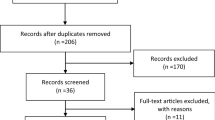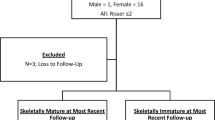Abstract
Purpose
This retrospective chart review evaluates the clinical and radiographic outcomes of anterior vertebral body tethering (VBT) at 1-year follow-up. Anterior VBT offers a fusionless treatment option for skeletally immature patients with adolescent idiopathic scoliosis. It is a growth-modulation technique, which utilizes patients’ growth to attain progressive scoliosis correction. Numerous animal models support its promise; however, clinical data remain sparse.
Methods
Clinical and radiographic data were retrospectively analyzed. We reviewed 32 patients who underwent thoracic VBT with a minimum one-year follow-up. Pertinent clinical and radiographic data were collected. ANOVA, Student’s t test and Fisher’s exact test were utilized to compare different time points.
Results
32 patients with thoracic idiopathic scoliosis (72 % female) with a minimum one-year follow-up were identified; mean age at surgery was 12 years. All patients were considered skeletally immature pre-operatively; mean Risser score 0.42, mean Sanders score 3.2. Patients underwent tethering of an average of 7.7 levels (range 7–11). Median blood loss was 100 cc. The mean pre-operative thoracic curve magnitude was 42.8° ± 8.0° which corrected to 21.0° ± 8.5° on first erect and 17.9° ± 11.4° at most recent. The pre-operative lumbar curve of 25.2° ± 7.3° demonstrated progressive correction (first erect = 18.0° ± 7.1°, 1 year = 12.6° ± 9.4°, p < 0.00001). Thoracic axial rotation measured 13.4° pre-operatively and 7.4° at the most recent measurement (p < 0.00001). One patient experienced prolonged atelectasis which required a bronchoscopy; otherwise, no major complications were observed.
Conclusions
Our early results indicate that anterior VBT is a safe and potentially effective treatment option for skeletally immature patients with idiopathic scoliosis. These patients experienced an improvement of their scoliosis with minimal major complications. However, longer term follow-up of this cohort will reveal the true benefits of this promising technique.
Level of evidence
IV.

Similar content being viewed by others
References
Nachemson AL, Peterson LE (1995) Effectiveness of treatment with a brace in girls who have adolescent idiopathic scoliosis. A prospective, controlled study based on data from the Brace Study of the Scoliosis Research Society. J Bone Joint Surg Am 77(6):815–822
Weinstein SL, Dolan LA, Wright JG, Dobbs MB (2013) Effects of bracing in adolescents with idiopathic scoliosis. N Engl J Med 369(16):1512–1521. doi:10.1056/NEJM0a1307337
Charles YP, Daures JP, de Rosa V, Dimeglio A (2006) Progression risk of idiopathic juvenile scoliosis during pubertal growth. Spine (Phila Pa 1976) 31(17):1933–1942
D’Amato CR, Griggs S, McCoy B (2001) Nighttime bracing with the Providence brace in adolescent girls with idiopathic scoliosis. Spine (Phila Pa 1976) 26(18):2006–2012
Dolan LA, Weinstein SL (2007) Surgical rates after observation and bracing for adolescent idiopathic scoliosis: an evidence-based review. Spine (Phila Pa 1976) 32(19 Suppl):S91–S100
Fallstrom K, Cochran T, Nachemson A (1986) Long-term effects on personality development in patients with adolescent idiopathic scoliosis. Influence of type of treatment. Spine (Phila Pa 1976) 11(7):756–758
Misterska E, Glowacki M, Latuszewska J (2012) Female patients’ and parents’ assessment of deformity- and brace-related stress in the conservative treatment of adolescent idiopathic scoliosis. Spine (Phila Pa 1976) 37(14):1218–1223. doi:10.1097/BRS.0b013e31824b66d4
Helfenstein A, Lankes M, Ohlert K, Varoga D, Hahne HJ, Ulrich HW, Hassenpflug J (2006) The objective determination of compliance in treatment of adolescent idiopathic scoliosis with spinal orthoses. Spine (Phila Pa 1976) 31(3):339–344
DiRaimondo CV, Green NE (1988) Brace-wear compliance in patients with adolescent idiopathic scoliosis. J Pediatr Orthop 8(2):143–146
Hasler CC, Wietlisbach S, Buchler P (2010) Objective compliance of adolescent girls with idiopathic scoliosis in a dynamic Spine Cor brace. J Child Orthop 4(3):211–218
Nicholson GP, Ferguson-Pell MW, Smith K, Edgar M, Morley T (2003) The objective measurement of spinal orthosis use for the treatment of adolescent idiopathic scoliosis. Spine (Phila Pa 1976) 28(19):2243–2250
Danielsson AJ, Romberg K, Nachemson AL (2006) Spinal range of motion, muscle endurance, and back pain and function at least 20 years after fusion or brace treatment for adolescent idiopathic scoliosis: a case-control study. Spine (Phila Pa 1976) 31(3):275–283
Kepler CK, Meredith DS, Green DW, Widmann RF (2012) Long-term outcomes after posterior spine fusion for adolescent idiopathic scoliosis. Curr Opin Pediatr 24(1):68–75
Green DW, Lawhorne TW, Widmann RF, Kepler CK, Ahern C, Mintz DN, Rawlins BA, Burke SW, Boachie-Adjei O (2011) Long-term magnetic resonance imaging follow-up demonstrates minimal transitional level lumbar disc degeneration after posterior spine fusion for adolescent idiopathic scoliosis. Spine (Phila Pa 1976) 36(23):1948–1954. doi:10.1097/BRS.0b013e3181ff1ea9
Betz RR, Ranade A, Samdani AF, Chafetz R, D’Andrea LP, Gaughan J, Asghar J, Grewal H, Mulcahey MJ (2010) Vertebral body stapling: a fusionless treatment option for a growing child with moderate idiopathic scoliosis. Spine (Phila Pa 1976) 35(2):169–176
Newton PO, Fricka KB, Lee SS, Farnsworth CL, Cox TG, Mahar AT (2002) Asymmetrical flexible tethering of spine growth in an immature bovine model. Spine (Phila Pa 1976) 27(7):689–693
Newton PO, Farnsworth CL, Faro FD, Mahar AT, Odell TR, Mohamad F, Breisch E, Fricka K, Upasani V, Amiel D (2008) Spinal growth modulation with an anterolateral flexible tether in an immature bovine model: disc health and motion preservation. Spine (Phila Pa 1976) 33:724–733
Crawford CH 3rd, Lenke LG (2010) Growth modulation by means of anterior tethering resulting in progressive correction of juvenile idiopathic scoliosis: a case report. J Bone Joint Surg Am 92(1):202–209
Newton PO, Farnsworth CL, Upasani VV, Chambers RC, Varley E, Tsutsui S (2011) Effects of intraoperative tensioning of an anterolateral spinal tether on spinal growth modulation in a porcine model. Spine (Phila Pa 1976) 36(2):109–117
Braun JT, Ogilvie JW, Akyuz E, Brodke DS, Bachus KN (2006) Creation of an experimental idiopathic-type scoliosis in an immature goat model using a flexible posterior asymmetric tether. Spine (Phila Pa 1976) 31(13):1410–1414
Sanders JO, Browne RH, McConnell SJ, Margraf SA, Cooney TE, Finegold DN (2007) Maturity assessment and curve progression in girls with idiopathic scoliosis. J Bone Joint Surg Am 89(1):64–73
Newton PO, Yaszay B, Upasani VV, Pawelek JB, Bastrom TP, Lenke LG, Lowe T, Crawford A, Betz R, Lonner B (2010) Preservation of thoracic kyphosis is critical to maintain lumbar lordosis in the surgical treatment of adolescent idiopathic scoliosis. Spine (Phila Pa 1976) 35(14):1365–1370
Conflict of interest
None.
Author information
Authors and Affiliations
Corresponding author
Additional information
IRB statement: IRB approval for the study was obtained from Temple University School of Medicine.
Rights and permissions
About this article
Cite this article
Samdani, A.F., Ames, R.J., Kimball, J.S. et al. Anterior vertebral body tethering for immature adolescent idiopathic scoliosis: one-year results on the first 32 patients. Eur Spine J 24, 1533–1539 (2015). https://doi.org/10.1007/s00586-014-3706-z
Received:
Revised:
Accepted:
Published:
Issue Date:
DOI: https://doi.org/10.1007/s00586-014-3706-z




